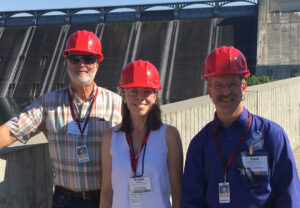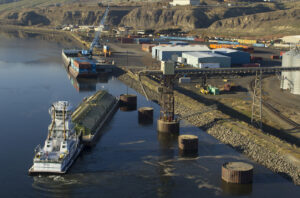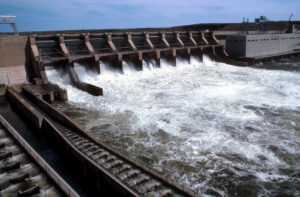The Pacific Northwest Waterways Association (PNWA) is a trade association that brings together ports, businesses, public agencies, and individuals to support navigation, energy, trade, and economic development in the Pacific Northwest. One of the industries it helps support is irrigated agriculture in eastern Washington, Idaho, and Oregon. Barge traffic on the Columbia and Snake Rivers, for instance, is a major method by which irrigated crops are shipped to the coast and around the world. In this interview, PNWA Executive Director Kristin Meira tells Irrigation Leader about the association’s work and its importance for irrigated ag farmers.
Irrigation Leader: Please tell us about your background.
Kristin Meira: I grew up in farm country, but far away from the Northwest. I grew up in South Jersey, about 45 minutes east of Philadelphia. The area was actually quite rural. I was a 4‑H girl my whole life—I went all through the program and have nothing but great things to say about it. I had lots of friends who were in Future Farmers of America.
I went to Rutgers University, and during my senior year, I was fortunate enough to have an internship in the governor’s office in Trenton. My first job out of school was working in New Jersey politics for a couple of years. I then moved to Washington, DC, and worked for Senator Bill Bradley during his final 2 years in the Senate before he retired. Then I went to work for Senator Patty Murray of Washington State. That began my love affair with the Pacific Northwest.
I worked for Senator Murray for 3 years and then moved to Portland, Oregon, in 2000. I’ve been out here ever since, and of the almost 21 years I’ve spent here, I have worked for 19 with PNWA.
Irrigation Leader: Tell us about PNWA and its members and mission.
Kristin Meira: PNWA is a trade association that has been around since 1934. It got its start in Walla Walla, Washington. Its original goal was to ensure that navigation locks were part of every dam project that went in on the Columbia and Snake Rivers. That represented an early recognition of how connected we all are and the importance of water transport for marketing our products. In the early 1970s, PNWA expanded and absorbed an existing coastal navigation group. That’s really when we became the association we are today.
Today, more than 145 organizations are members of PNWA, and we just keep growing. We bring together viewpoints from eastern and western Washington, Oregon, Idaho, and beyond. Our members include farmers, ports, terminals, towboat companies, rail lines, pilots, union labor, irrigation interests, and utilities. All those folks have different perspectives about water resources, trade, and transportation, but we find that they are united by their belief in the importance of infrastructure for how we grow and make things in the Northwest and then move them out to market.

Irrigation Leader: How much is transported on the river system?
Kristin Meira: In 2018, the last year for which the U.S. Army Corps of Engineers has published data, more than 56 million tons of cargo moved out on the Columbia and Snake Rivers. It’s an incredibly important export gateway, not just for the Northwest and the West Coast, but for the United States as a whole. The ports of Seattle and Tacoma in Puget Sound are also incredibly important load centers. We are blessed in the Northwest with ports of different stripes, serving different functions, but all important to our competitiveness.
Irrigation Leader: Would you give us a sense of the number of jobs that the transport network supports?
Kristin Meira: I think our industry needs to improve its methods of calculating direct, indirect, and induced employment numbers. Oregon and Washington are two of the most trade-dependent states in the nation, with over 40,000 jobs dependent upon commerce on the deep-draft lower Columbia River alone. For our region’s overall waterborne transportation system, at the moment, I only have back-of-the-napkin numbers that I wouldn’t want to put out there. I will say that a lot of our members are

from what I would characterize as the unseen sectors of the U.S. economy—the folks who are growing and making things and then moving those products. The infrastructure that they rely on is also largely unseen, especially water infrastructure. So much of it is underwater. You just don’t think about it in the way that you think about a road that you’re driving on or a bridge, airport, or rail line that you see out your car window. We have to speak with a coordinated voice, especially in Washington, DC, because otherwise these sectors and this infrastructure will remain unseen and unconsidered.
Irrigation Leader: What are PNWA’s top issues?
Kristin Meira: These days, we are heavily focused on infrastructure. In so many parts of our country’s infrastructure portfolio, we are coasting on the investments that were made by the generations that came before us. We’re struggling to maintain the infrastructure we have, let alone to build new things and gain new efficiencies. We want to have serious conversations in Washington, DC, about how to seriously fund infrastructure in our country. We have a laundry list of projects we want to pursue in the Northwest, including roads, rail, and ports.
Another overarching theme that our membership is thinking about is how to strike the right balance when it comes to our water resources in the Northwest—how to plan and manage those water resources so that they produce high-value crops while also protecting fish and other species. Our irrigated ag farmers, for example, are stewards of the land and water. They know the value of every drop of water, and they know that they have some of the highest-quality and most productive lands in the country. But they also know that if they don’t care for it in the right way, it can’t produce all those high-value crops. Our members think of themselves as conservationists and environmentalists. They know the importance of managing all those things, and they also know that the way in which they interact with our rivers can have positive or negative effects on fish runs.
Irrigation Leader: What can you tell us about the importance of navigation and transportation on the Snake River?
Kristin Meira: The Snake River is a part of the Northwest that many people will never get to see. Especially in southeastern Washington, the river is essentially in a canyon. It doesn’t have an interstate adjacent to it, as is the case with I-84 and the Columbia. Perhaps as a result, not a lot of folks know about the important role that it plays for hydropower production and transportation. In any given year, nearly 10 percent of all U.S. wheat exports are transported by barge on the Snake River. Barge transport is the most efficient, safest, and least carbon-intensive method of cargo transport. If you wanted to move the cargo that was shipped by barge on the Snake River in 2018 by rail or road instead, it would have required more than 35,000 rail cars or almost 150,000 semi trucks. Rail and road are critical for moving cargo in the Northwest as well, but they represent more safety risks because there’s more human interaction than in barging.

Barges carrying agricultural products on the Columbia and Snake Rivers range in length from just over 200 to almost 300 feet in length, with a width of 42 feet and depths of up to 16.5 feet. The standard four-barge tow carries over 14,000 tons—as much as 140 train hopper cars or 538 semi trailers.
Snake River dams are critical for hydropower production and barging, and we also know that they are some of the most fish-friendly dams in the entire Pacific Northwest, with over 95 percent of juvenile salmon surviving passage at each one. Those are numbers that are not achieved even in many undammed rivers. A lot of effort has gone into those dams. They were built with fish passage structures and have never blocked fish, and the Army Corps has been making steady improvements to them since. Today, they have truly world-class fish passage facilities. They have virtually no effect on survival figures. They are examples of what we hope can be achieved at other dams in the Northwest and beyond.
Irrigation Leader: What should Congress know about your members and your top legislative priorities for this year?
Kristin Meira: Goal number 1 is the right infrastructure policy and adequate funding for infrastructure. We do have a laundry list of projects here in the Northwest, all with a goal of balanced use of water for salmon recovery, transportation, energy, irrigation, and recreation. We know that we share these rivers with our fish, and we want to see that balance achieved. We also want more recognition of the threats to salmon and steelhead across their life cycles. We’re learning more every day from salmon scientists about the challenges these fish face in our oceans. We know that ocean warming, ocean acidification, and urban runoff are common denominators for our struggling West Coast fish runs. We would encourage readers to read about these ocean-based problems for fish on the National Oceanic and Atmospheric Administration’s website.
Irrigation Leader: What are the top priorities for Washington irrigated ag farmers?

Kristin Meira: We know that our farmers can do everything right with their crops, but if our port areas aren’t efficient, they can’t compete in tough overseas markets. With that in mind, we have two high-priority navigation projects that are relevant to irrigated ag farmers. At the coastal ports in Puget Sound, there are important channel-deepening projects at the ports of Seattle and Tacoma that are ready to proceed. Those are two of the most important container ports in the United States, and we need them to be able to host the largest container vessels in the world to stay competitive. We also need to make sure that the jetties at the mouth of the lower Columbia River are in good shape and can protect the vessels departing with our export cargo. If there is an issue with those jetties and vessels cannot pass, everything we do inland is for naught. The rest of the supply chain will close down.
Irrigation Leader: Have you ever done tours of the river for your members?
Kristin Meira: We do lots of tours, but the pandemic has certainly curtailed that for now. One of the most recent and special tours we did was in summer 2019 with a group of legislators from Olympia. We got on a vessel in Kennewick; went upriver; and locked through Ice Harbor Dam, the first dam to the east on the Snake River. We tied up there, got off the vessel, went into the dam and the powerhouse, and saw where hydropower was being generated. We also talked about access to water. That’s one of the pools that is so important to our Washington irrigated farmers. It was almost a full-day affair, and it was pretty special. There were a lot of Washington State legislators there who had never been to the river, let alone on the river or to a dam or navigation lock. It opened their eyes to the river system and what it means to the people who live in that area.
Jon DeVaney is the president of the Washington State Tree Fruit Association. He can be contacted at jon@wstfa.org or (509) 452‑8555.

